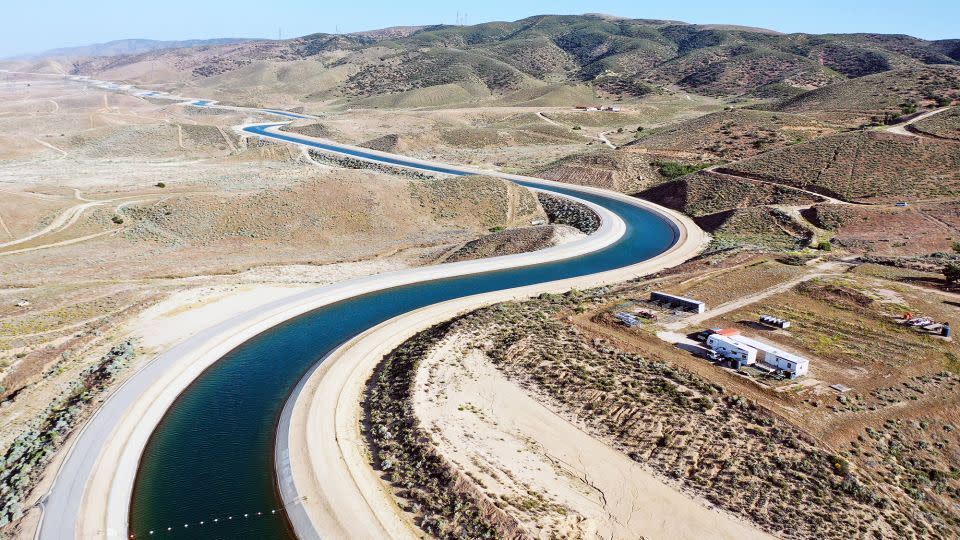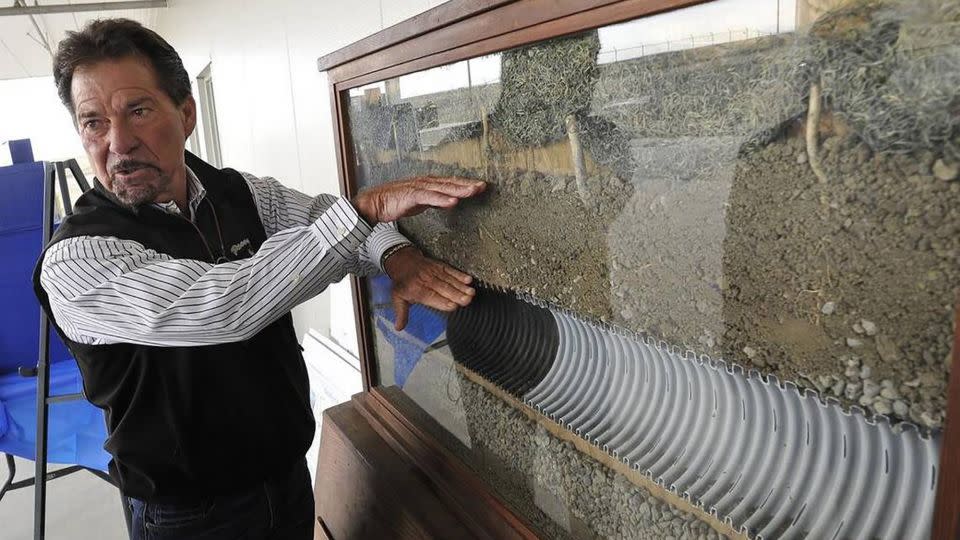‘Chinatown,’ released 50 years ago, was inspired by some shocking real-life events that still hold water today
- Oops!Something went wrong.Please try again later.
In the 1974 film “Chinatown,” there’s deceit, deception and murder, as well as a timeless Los Angeles protagonist – water.
Having debuted 50 years ago this week, “Chinatown” is set against a race for control of water in arid LA, and some of the devious power players who are after that control, along with the money that goes with it.
An Oscar-winner for Robert Towne’s original screenplay (out of 11 total Academy Award nominations), “Chinatown” remains an indelible entry in the film noir genre, updating it with a complex and emotional story, while also shedding light on some of the real-life history of the city’s rise. Intrinsic to LA’s story is how water was – and still is – accessed by the city, a history riddled with disaster and corruption.
“It’s astonishing in the way (‘Chinatown’) centralizes water as a character in the growth of Los Angeles,” William Deverell, co-director of the Huntington-USC Institute on California and the West and professor of history at the USC Dornsife College of Letters, Arts and Sciences, told CNN in a recent interview.
“It’s a brilliant movie that gives us the feel of this water capture from the early 20th century, bringing the Sierra snow melt river 250 miles down to Los Angeles.”
The movie follows private eye Jake Gittes (Jack Nicholson) as he crosses paths with a wronged woman (Faye Dunaway) and gets drawn into the complicated criminal underbelly of 1930s-era Los Angeles. In the process, he unwittingly uncovers a secret plan on the part of some men in power to buy up cheap, dry land on the outskirts of the city and divert much-desired water from even further away to those areas, thereby causing the value of that land to skyrocket.
Drops of truth in a Hollywood fable
While the broad strokes of that story are true, they deviate from what actually happened in two ways, according to Deverell.
“The movie shrouds the scheme in secrecy and conspiracy – enough to provoke murder – but Angelenos basically knew that a set of already rich men would get richer when the water came (and watered their lands in the newly-annexed San Fernando Valley),” he said. “They didn’t much care, as they knew that there was water and land enough to float many more boats, so to speak, than the oligarchs in on the ground floor.”
Essentially, the pursuit to bring water – which Deverell referred to as “the coin of the realm” – to LA and its outskirts was not a secret. “Deliberate, planned, carefully executed, thoughtfully engineered, sneakily done,” he said, just not clandestine.
The other main deviation that “Chinatown” takes is the era in which much of this long-distance irrigation was done.
The efforts to divert water from the faraway Owens Valley near Mammoth Lakes, CA – some 230 miles from Los Angeles – began as early as 1908, with the start of the construction of the Los Angeles Aqueduct. Deverell called the project “the prime infrastructural focus” or inspiration of “Chinatown.” The Roman Polanski-directed film, meanwhile, takes place some 25 years later.
Uprisings, disasters and mayhem
But regardless of these meanderings from the truth, the “Water Wars” (as they came to be known) that inspired the movie reflected real-life mayhem. The aqueduct opened in 1913, and swiftly desiccated the areas where it originated, resulting in an uprising in 1924 on the part of local farmers who used dynamite in an attempt to blow up part of the infrastructure that was routinely drying up their land.
“Tensions and litigation continue well into contemporary times: the desiccated Owens Lake is getting some water put back in, but the issues continue to be hotly debated and contested,” Deverell explained. “It’s moved generally from riparian tugs of war into deep environmental terrain, all having to do with essentially picking up a river and moving it hundreds of miles away.”

In “Chinatown,” the murder of Hollis Mulwray – Dunaway’s character’s husband (played by actor Darrell Zwerling) – incites much of the movie’s action. His death follows his refusal to endorse a dam that he believed would prove faulty. In actuality, celebrated SoCal engineer William Mulholland built the St. Francis Dam that failed in 1928, resulting in the “largest single loss of life in California history,” according to Deverell.
“His career was shattered,” he said, adding that even though we have things named for him, like the famed Mulholland Drive, “there is this darker, obviously tragic past.”
The ‘Water Wars’ of today
As the dry, hot periods get drier and hotter due to climate change – ask any longtime Los Angeleno about the recent wet weather in LA, and they will be quick to tell you drought-like conditions will indeed return as they always do – it’s no surprise, perhaps, that the pursuit of water in the region has continued to inspire people to act outside of the law to grab some of the “liquid gold.”
Take Dennis Falaschi, the former general manager of the Panoche Water District in the Central Valley. In a 2022 federal indictment, Falaschi was accused of conspiring to steal more than $25 million in water over a 20-year period. Late last month, he struck a deal and pleaded guilty to filing a false tax return and to conspiring to steal water valued somewhere between $1.5 million and $3.5 million. He awaits sentencing in September. His attorney had no comment when reached by CNN.
The indictment also indicates “that Mr. Falaschi was just one of several individuals” who were illegally drawing water from the federally-owned canal.
“There was an old, rusted kind of former piece of irrigation equipment that was taking in some water from the Delta Mendota Canal,” said Jessica Garrison, a Northern California correspondent for the Los Angeles Times who reported on the Falaschi case extensively. Garrison explained that after the faulty piece of equipment was discovered, instead of fixing it, “they put a gate in and they started just taking water out of the canal without a meter, without anybody knowing, often in the dead of night.”

Sounds worthy of a Hollywood tale on its own.
“If you start looking for it, people are stealing water all over the place,” Garrison also said. “I mean, it is everybody from farmers to movie stars, anyone who’s trying to grow anything in California, many of those people have been caught up in various water theft schemes.”
Even actor Tom Selleck was caught up in one, settling with the Calleguas Municipal Water District in July 2015 after allegedly diverting water to his ranch during an ongoing drought. And that’s not to mention other Hollywood figures who made headlines for allegedly violating local drought restrictions, from Sylvester Stallone and Kevin Hart to the Kardashians.
A ‘takeaway for the ages’
“I think the beauty of ‘Chinatown’ is that California is to some extent built on stolen water,” Garrison noted, going on to say “there’s lots of different ways to steal water. You can steal it legally, you can steal a little bit, you can steal a lot.”
Deverell echoed the sentiment. “We have ‘water on the brain’ — which is one of the lines from the movie, yes, because we have to,” he said of Southern Californians. “There’s a presumption… that water is dull, and it’s anything but dull. The legal record around water, the fights, the manipulations, the engineering, the uncertainties. Water is fascinating. It’s because it’s so fundamental.”
Although “Chinatown” is now half a century old, its themes endure.
“Fifty years later… The deeper story about water and intrigues around water, its importance, Its fundamental quality, what people will do to get it, how depraved they will be,” Deverell said. “That is a takeaway for the ages. That is something we can all think hard about to make sure in our town, our community, our county, our states, our region that the depravity is kept to a minimum.”
For more CNN news and newsletters create an account at CNN.com
